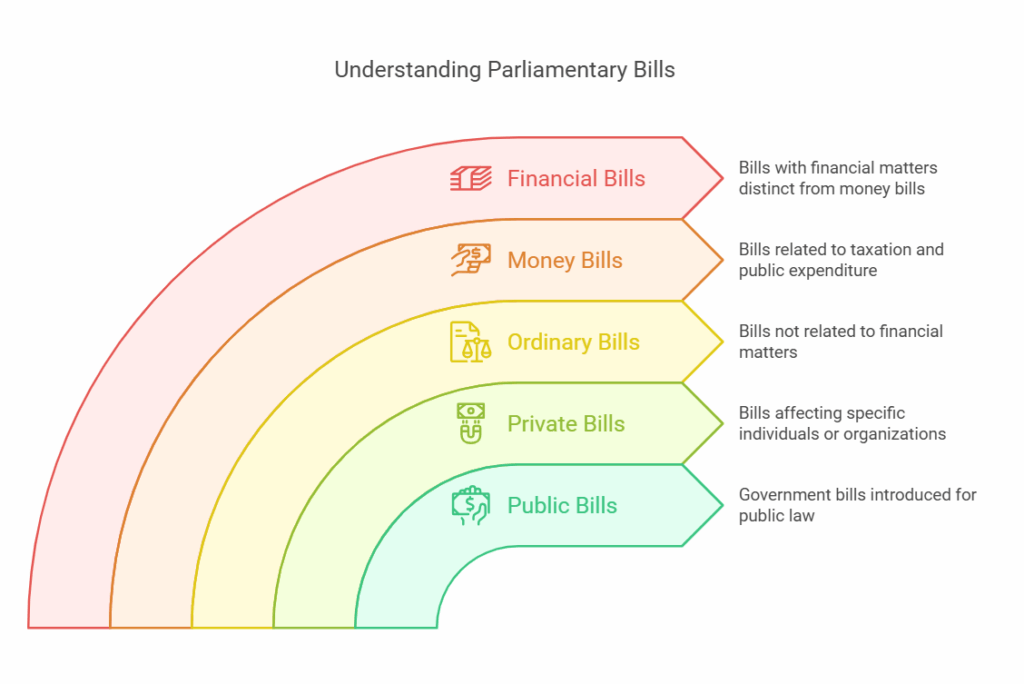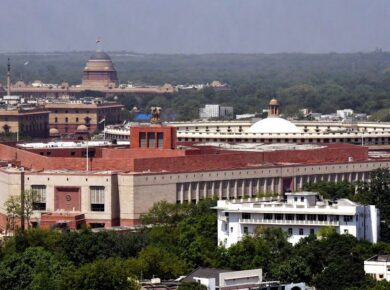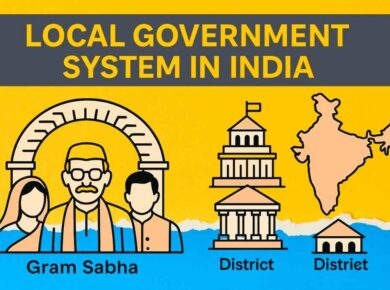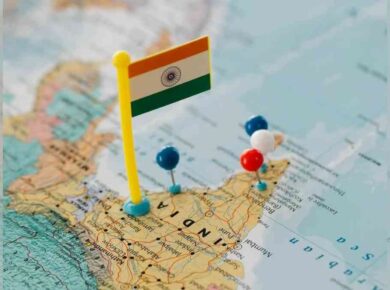Bills in Parliament
Government member bill
Bill introduced by a minister of government, can be –
- Ordinary bill
- Money bill
- Financial bill
- Constitutional amendment bill
As it is moved by the government itself, President does not interfere in introduction of the bill as he is obligatory to advice of COM
Private member bill
- A bill introduced by a non-government member
- President can use his powers of absolute veto & can reject the bill, provided bill comes for tabling in the house before presidential recommendation
- Every member can introduce a bill only for 4 times a year
Types of Bills
| Ordinary | Money | Financial | Constitutional amendment | |
| Introduced in | RS & LS | LS | LS | RS & LS |
| Introduced as | Gov. + Private member bill | Gov. member bill | Gov. member bill | Gov. + Private member bill |
| Presidential assent in intro | Required | Required | Required | Not Required |
| Provision for joint sitting | Applicable | NA | Applicable | NA |
| Passing Majority | Simple majority (X > 50 %) | Simple majority (X > 50 %) | Simple majority (X > 50 %) | Special Majority (X > 2/3 of members present & voting) |
Stages of bill
Introduction of the bill (1st reading of the bill)
- Provisions of proposed law + statement of objects & reasons
- If a private member wishes to introduce a bill, he must give one-month prior notice of his intentions to introduce the bill, seeking permission of the house to do so.
- Usually, it is not opposed but if it is opposed, proposal is put to vote & if house is in favour of introduction of bill, then it proceeds to next stage
- After the bill is introduced in house, it is published in Gazette of India
2nd Reading of the bill
- Principles of the bill are discussed thoroughly & members make speech about for or against the principles of the bill
- Clause, schedules & amendment regarding bill are taken into consideration
- Bill can be referred to selection committee (Committee of the house) or can be referred to joint committee (joint committee of both the houses)
- If the bill is referred to joint / selection committee, they shall give their report (unanimously or via majority) within specified date (with amendments, if required)
- Reports & bill (as amended) are printed & made available to members of the house (Report stage of the bill)
- Bill is then taken up for consideration clause by clause
- This is the stage where bill undergoes substantial changes & amended if found necessary
3rd Reading of the bill
- Final reading & more or less a formal affair
- Debate is confined to acceptance or rejection of the bill & submitted to vote of the house
- If accepted, it is passed to other house & same process follows.
- Other house has mainly 4 alternatives viz.
- May pass the bill without amendments
- May pass the bill with amendments > In this case, Bill is returned to originating house. If originating house accepts the amended bill, it would deem to have been passed by both the houses. However, if originating house does not agree with it, President may summon a joint meeting of both the houses to resolve the disagreement & deadlock
- It may reject the bill altogether. President may summon joint sitting of both the houses to resolve the deadlock
- May not take any action on the bill by keeping it lying on the table. After lapse of 6 months from the date of reception of the bill, President may summon joint sitting of both the houses to resolve the deadlock
 Joint sitting of the Parliament
Joint sitting of the Parliament
- Presided over by Speaker of Lok sabha, then in his absence, Deputy Speaker of LS, then in his absence, Deputy Chairman of RS & even in his absence any member as agreed by both the houses
- Deadlock is resolved by total number of members of both the houses present & voting. Generally, will of LS prevails due to its larger size
- After the passage of the bill, it is presented to the President for his assent
No provision of Joint sitting for Money bill & constitutional amendment bill[/notification]
Presidential Assent
- If it is money bill or constitutional amendment bill he has to give his assent, but in case of any other bill, he may return it to the parliament for reconsideration with his recommendations
- If bill is passed again, with or without amendments & sent to the President for the 2nd time, he has to give his assents.
- After the assent of the President, Bill becomes an act
Money & Financial Bills
Bill of Appropriation
- A bill which empowers government to draw some amount from consolidated fund of India
Money Bill
- Decision of speaker is final weather a bill is money bill or not. His decision cannot be challenged in any court of law or any of the houses or by the President.
- Money bill can only be introduced in Lok sabha with recommendations of President
Provisions For money bill
- Imposition, abolition, remission, alteration or regulation of any tax
- Regulating & borrowing money from the government
- Money into or out of consolidated fund of India
- Any expenditure charged on consolidated fund of India or to increase amount of such expenditure
- Receipt or withdrawal of custody of public accounts of India or audit of account of union or state
Rajya Sabha on Money Bill
- Rajya Sabha cannot amend or reject a money bill but only plays a recommendatory role in passing of money bill.
- RS must return the money bill within 14 days to LS with or without any recommendations
- Weather LS accepts or does not except recommendations of RS, bill is deemed to have been passed by both the houses
- Now bill is forwarded to President for his assent & he is bound to give his assent to the bill
Financial Bill
- Apart from the provisions of money bill, it includes other provisions as well & can be introduced in LS only on the recommendations of President
- Since it includes other matters also RS has equal say to amend or reject it by virtue of its powers
- President can also send the bill for reconsideration for once
If you’re passionate about building a successful blogging website, check out this helpful guide at Coding Tag – How to Start a Successful Blog. It offers practical steps and expert tips to kickstart your blogging journey!
For dedicated UPSC exam preparation, we highly recommend visiting www.iasmania.com. It offers well-structured resources, current affairs, and subject-wise notes tailored specifically for aspirants. Start your journey today!







2 comments
T Types of Bills-Comparision chart is very helpful for the preperation. Good work !!! Keep going
Correction: Presidential assent in intro for ordinary bill Not Required but for money bill Required